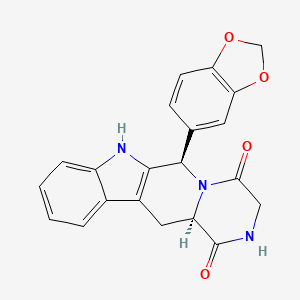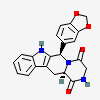Nortadalafil
- Nortadalafil
- 171596-36-4
- Demethyltadalafil
- N-Desmethyl Tadalafil
- Demethyl Tadalafil
- Create:2006-10-25
- Modify:2025-01-18

- Nortadalafil
- 171596-36-4
- Demethyltadalafil
- N-Desmethyl Tadalafil
- Demethyl Tadalafil
- (+)-Nortadalafil
- 5W59DMB3LD
- CHEMBL342008
- (2R,8R)-2-(1,3-benzodioxol-5-yl)-3,6,17-triazatetracyclo[8.7.0.03,8.011,16]heptadeca-1(10),11,13,15-tetraene-4,7-dione
- 629652-62-6
- Desmethyltadalafil (Nortadalafil)
- (6R,12aR)-6-(1,3-Benzodioxol-5-yl)-2,3,6,7,12,12a-hexahydropyrazino(1',2':1,6)pyrido(3,4-b)indole-1,4-dione
- (6R,12aR)-6-(benzo[d][1,3]dioxol-5-yl)-2,3,6,7,12,12a-hexahydropyrazino[1',2':1,6]pyrido[3,4-b]indole-1,4-dione
- Pyrazino(1',2':1,6)pyrido(3,4-b)indole-1,4-dione, 6-(1,3-benzodioxol-5-yl)-2,3,6,7,12,12a-hexahydro-, (6R,12aR)-
- Pyrazino(1',2':1,6)pyrido(3,4-b)indole-1,4-dione, 6-(1,3-benzodioxol-5-yl)-2,3,6,7,12,12a-hexahydro-, (6R-trans)-
- C21H17N3O4
- Nortadalafil?
- Tadalafil-Nor
- Desmethyl Tadalafil
- Pyrazino[1',2':1,6]pyrido[3,4-b]indole-1,4-dione, 6-(1,3-benzodioxol-5-yl)-2,3,6,7,12,12a-hexahydro-, (6R,12aR)-; Pyrazino[1',2':1,6]pyrido[3,4-b]indole-1,4-dione, 6-(1,3-benzodioxol-5-yl)-2,3,6,7,12,12a-hexahydro-, (6R-trans)-; Nortadalafil
- MFCD19443817
- TADALAFIL_met023
- UNII-5W59DMB3LD
- SCHEMBL1326910
- DTXSID40431339
- GLXC-27041
- BDBM50134133
- AKOS027250761
- CS-0823
- AS-56845
- DA-56263
- HY-90009
- C90282
- EN300-20385208
- Q27262952
- Z3244741608
- (2R,8R)-2-(1,3-dioxaindan-5-yl)-3,6,17-triazatetracyclo[8.7.0.0^{3,8}.0^{11,16}]heptadeca-1(10),11(16),12,14-tetraene-4,7-dione
- (2R,8R)-2-(2H-1,3-benzodioxol-5-yl)-3,6,17-triazatetracyclo[8.7.0.0?,?.0??,??]heptadeca-1(10),11(16),12,14-tetraene-4,7-dione
- (5R,6R)-6-Benzo[1,3]dioxol-5-yl-2,3,6,7,12,12a-hexahydro-pyrazino[1'',2'':1,6]pyrido[3,4-b]indole-1,4-dione
- Pyrazino[1 inverted exclamation marka,2 inverted exclamation marka:1,6]pyrido[3,4-b]indole-1,4-dione, 6-(1,3-benzodioxol-5-yl)-2,3,6,7,12,12a-hexahydro-, (6R,12aR)-rel-

H315 (100%): Causes skin irritation [Warning Skin corrosion/irritation]
H319 (100%): Causes serious eye irritation [Warning Serious eye damage/eye irritation]
H335 (100%): May cause respiratory irritation [Warning Specific target organ toxicity, single exposure; Respiratory tract irritation]
P261, P264, P264+P265, P271, P280, P302+P352, P304+P340, P305+P351+P338, P319, P321, P332+P317, P337+P317, P362+P364, P403+P233, P405, and P501
(The corresponding statement to each P-code can be found at the GHS Classification page.)
Skin Irrit. 2 (100%)
Eye Irrit. 2A (100%)
STOT SE 3 (100%)
Patents are available for this chemical structure:
https://patentscope.wipo.int/search/en/result.jsf?inchikey=XHDLVMPUSXRZOS-FOIQADDNSA-N
- CAS Common ChemistryLICENSEThe data from CAS Common Chemistry is provided under a CC-BY-NC 4.0 license, unless otherwise stated.https://creativecommons.org/licenses/by-nc/4.0/rel-(6R,12aR)-6-(1,3-Benzodioxol-5-yl)-2,3,6,7,12,12a-hexahydropyrazino[1′,2′:1,6]pyrido[3,4-b]indole-1,4-dionehttps://commonchemistry.cas.org/detail?cas_rn=629652-62-6
- ChemIDplusChemIDplus Chemical Information Classificationhttps://pubchem.ncbi.nlm.nih.gov/source/ChemIDplus
- EPA DSSToxNortadalafilhttps://comptox.epa.gov/dashboard/DTXSID40431339CompTox Chemicals Dashboard Chemical Listshttps://comptox.epa.gov/dashboard/chemical-lists/
- European Chemicals Agency (ECHA)LICENSEUse of the information, documents and data from the ECHA website is subject to the terms and conditions of this Legal Notice, and subject to other binding limitations provided for under applicable law, the information, documents and data made available on the ECHA website may be reproduced, distributed and/or used, totally or in part, for non-commercial purposes provided that ECHA is acknowledged as the source: "Source: European Chemicals Agency, http://echa.europa.eu/". Such acknowledgement must be included in each copy of the material. ECHA permits and encourages organisations and individuals to create links to the ECHA website under the following cumulative conditions: Links can only be made to webpages that provide a link to the Legal Notice page.https://echa.europa.eu/web/guest/legal-notice(2R,8R)-2-(1,3-dioxaindan-5-yl)-3,6,17-triazatetracyclo[8.7.0.0^{3,8}.0^{11,16}]heptadeca-1(10),11,13,15-tetraene-4,7-dionehttps://echa.europa.eu/substance-information/-/substanceinfo/100.384.974(2R,8R)-2-(1,3-dioxaindan-5-yl)-3,6,17-triazatetracyclo[8.7.0.0^{3,8}.0^{11,16}]heptadeca-1(10),11,13,15-tetraene-4,7-dione (EC: 896-864-9)https://echa.europa.eu/information-on-chemicals/cl-inventory-database/-/discli/details/345357
- FDA Global Substance Registration System (GSRS)LICENSEUnless otherwise noted, the contents of the FDA website (www.fda.gov), both text and graphics, are not copyrighted. They are in the public domain and may be republished, reprinted and otherwise used freely by anyone without the need to obtain permission from FDA. Credit to the U.S. Food and Drug Administration as the source is appreciated but not required.https://www.fda.gov/about-fda/about-website/website-policies#linking
- CCSbaseCCSbase Classificationhttps://ccsbase.net/
- ChEMBLLICENSEAccess to the web interface of ChEMBL is made under the EBI's Terms of Use (http://www.ebi.ac.uk/Information/termsofuse.html). The ChEMBL data is made available on a Creative Commons Attribution-Share Alike 3.0 Unported License (http://creativecommons.org/licenses/by-sa/3.0/).http://www.ebi.ac.uk/Information/termsofuse.htmlChEMBL Protein Target Treehttps://www.ebi.ac.uk/chembl/g/#browse/targets
- Japan Chemical Substance Dictionary (Nikkaji)
- Wikidatanortadalafilhttps://www.wikidata.org/wiki/Q27262952
- PubChem
- GHS Classification (UNECE)GHS Classification Treehttp://www.unece.org/trans/danger/publi/ghs/ghs_welcome_e.html
- MolGenieMolGenie Organic Chemistry Ontologyhttps://github.com/MolGenie/ontology/
- PATENTSCOPE (WIPO)SID 389347168https://pubchem.ncbi.nlm.nih.gov/substance/389347168

